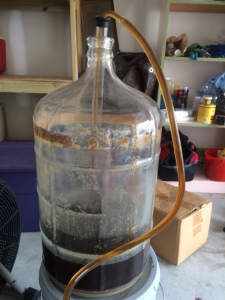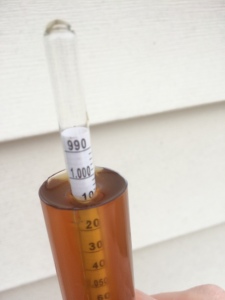This post is one in a series of making small adjustments to a single recipe in order to improve it, learn more about the impact each ingredient has on the finished product, and the art of recipe creation. The rest of the series can be found here.
Brew Day
Iteration 3 was a brew I was particularly excited about. Going into this brew day, I felt confident that this iteration would at least come very close to achieving the more complex dark fruit malt character I desired from this brew. The other complexities of the malt would be forthcoming, but I felt I was close with at least what I consider to be the most important aspect of the malt profile.
This brew day was like any other: I mashed in at my correct temperature and sparged accordingly. However, something strange happened this time that I can only guess at. When I got to the point of taking my hydrometer reading, I was disappointed to find a reading a full 10 gravity points lower than expected. Things began to come into focus when I finished transferring my cooled wort to the carboy. I had collected around half a gallon more than I had on my last brew day.
There are some aspects I’m still guessing at though. I measured out my mash/sparge water beforehand and collected as much as I had last time, accounting for grain absorption, etc. Actually, I should have collected slightly less (almost negligibly, though) due to the fact that I had 0.25 lbs. more grain in my mash tun than my last brew, and I didn’t change the volume of water collected. At least, I don’t think I did. I collected my water in vessels with known volumes, so that shouldn’t be a factor; however, I’m left with the fact that I collected more wort than I should have. I either measured incorrectly or wrote down my volume collected incorrectly from last time. Or some witchcraft that I cannot account for happened inside the mash tun. But, you know, science, I guess.
Whatever the reason, I’m left with two realizations. The first is that I need to be more careful when I measure my water out beforehand. The second realization is that it’s still incredibly disappointing to miss your target OG, even when the end result is extra beer.

Recipe
My main goal for this iteration was to build more complexity into my malt profile. As I didn’t want to change too much so that I could truly appreciate the impact of the variation, I knew going into this recipe that I was only going to add one malt to my grain bill. Iteration 2 certainly contained more of the dark fruit character that I wanted, but the flavor was missing something. Although the plum/cherry flavor was there, the beer almost tasted thin either because of the percentage of C120 or because I only used C120. I initially leaned towards the latter, and as I continued to drink Iteration 2, I became convinced that this was the case.
Due to this conclusion, I did end up addressing both of the questions I had from last time, which were:
- What malt do I add to the grain bill?
- Should I keep the percentage of C120 the same?
To determine which malt to add into the mix, I had to figure out what exactly was that elusive “something” that was missing from my last attempt at this recipe. I began by addressing the “thinness” I mentioned before. I certainly questioned my low mash temperature and low FG playing a part in this, but this truly was not a matter of mouthfeel. Rather, it was actually a “thinness” in the flavor. To clarify, I’ll try to explain what I mean when I describe this beer as being somewhat “thin.” I think it stems partly from expectations. What I want this beer to be eventually is rich and full in flavor but still have a light body. Where Iteration 2 landed was a one-dimensional addition that was not enough to stand out against the amount of 2-row employed in that recipe. For a pale ale, the 2-row/specialty grain ratio would be fine; however, this beer needs more malt character than that.
I had a few options before me. I considered adding some Victory or Munich to get some other flavors in the mix. I also considered exchanging some of my 2-row for Marris Otter. The other option I considered was to add some complexity surrounding the flavors I had already achieved by adding Special B. In the end, I decided that since I really want the dark fruit character of the grains to be the main focus in my malt profile, perhaps I should try to add complexity there to see if I could improve that before turning my focus on the supporting players. And truthfully, I’ve had Special B recommended to me so many times during the course of this process that I was really interested to give it a shot, so that may have swayed me some in my choice.
Once I had settled on using Special B, I had to decide if I wanted to do a simple addition to the recipe as it stood before or if I wanted to play around with my percentages some. I wanted to add complexity, but I was also concerned that too much would be overpowering. In light of that, I compromised and exchanged 1 lb. of C120 for 0.75 lbs. of C120 and 0.5 lbs. of Special B, giving more specialty grains total, but lowering the amount of C120 from the previous recipe.
- Mashed at 150⁰ F for 1.25 hrs.
- 10.25 lbs. 2-Row
- 0.75 lbs. Crystal 120
- 0.5 lbs. Special B
- Boiled for 1 hr.
- 0.5 oz. Simcoe (60 min) at 12.2% AA
- 0.5 oz. Simcoe (30 min) at 12.2% AA
- 0.5 oz. Cascade (15 min) at 5.0% AA
- 0.5 oz. Centennial (5 min) at 9.7% AA
- Pitched US-O5
- OG: 1.056
- FG: 1.008
- ABV: 6.3%
- Dry hopped 0.5 oz. Cascade and 0.5 oz. Centennial for 5 days.
- Bottled and primed with 4 oz. of priming sugar.

Tasting
The one thing I got right on this beer was the color. It may not look like it from the picture of the hydrometer sample above, but a full glass of this beer has a delightfully red hue. Like I said though, that’s perhaps the one thing I got right.
The aroma had a hint of citrus mingled with raisin. The flavor started with citrus and plum and held a rich maltiness. Although the citrus came through clearly up front, the raisin flavor of the finish at first clashed with the citrus and then masked it entirely, fading into a strong raisin and burnt sugar flavor.
Mistakes were made. In short, the Special B was not the right choice for this beer. It is certainly a flavor I might play around with in the future in, say, a strong ale, but its strong raisin flavor is not right for this red IPA.
Goals for the Next Brew
The citrus hop aroma and flavor of this beer (at least up front) seems to be the strongest of all the recipe iterations so far. I’m not entirely sure why that is, as I haven’t yet changed my hop regimen. The only thought I have on this is that the lower OG (from Iteration 2) was more appropriate for the amount of hops I added, thus allowing them to shine through. If this is true, it tells me what I already knew: this beer needs more hops to reach its potential. But again, I’ll save the hops until I’ve nailed the malt.
One aspect of this beer that is simultaneously positive and negative is the complexity. I wanted malt complexity, and I achieved a richness in the malt that was lacking in both Iterations 1 & 2. The problem, though, was that the flavors in this complexity weren’t quite right (as I mentioned, the raisin clashed with the citrus of the hops). I want to keep that level of complexity in the malt flavor without keeping this exact complexity.
The questions I’m left with for next time are:
- What grain should I use in place of the Special B that will yield richness and complexity when combined with the C120?
- Should I keep the amount of C120 the same, return it to its former amount, or use more than I have before?
